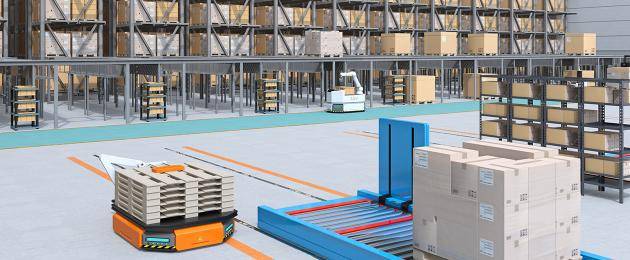
Flexible automation delivers improved warehouse operations
2300 Windy Ridge PKWY
Suite 700
Atlanta, GA 30339
Phone: 770 955-7070
Fax: 770 955-0302
http://www.manh.com
The booming market for eCommerce and direct-to-consumer (D2C) fulfillment, coupled with a challenging labor market, is putting immense pressure on companies to improve warehouse and fulfillment center operations. However, most organizations competing in this space do not have the scale or budget to invest in full automation.
So, how can those companies successfully compete in an increasingly automated industry? One answer is an investment in flexible automation enabled by modern autonomous mobile robotics (AMRs).
AMR market overview
Since 2012, the market for autonomous mobile robots has exploded. There are dozens of vendors – each with some unique form, feature, or function – providing warehouses and fulfillment centers with AMRs. This technology is taking on much of the movement of materials and helping to drastically improve operations in many ways. In fact, a recent market survey conducted at IDC found that over 70% of the time, commercial service robotic technology delivered double-digit improvements to productivity, efficiency and capacity.
Flexing capacity more affordably
Historically, meeting peak demand workflows meant flexing capacity by throwing bodies at the problem. The more people in the warehouse and/or fulfillment center, the more capacity increased. However, in today’s labor market, this becomes both a significant challenge and a very expensive proposition. The scarcity of workers today has increased competition for available labor and driven up temporary labor costs.
AMRs address this challenge by completing tasks humans traditionally would have handled such as pushing carts, or, in some cases, picking from shelves. This allows people to focus on other, higher value activities. And because many of the AMR vendors are willing to provide their robots “as-a-Service”, customers can now deploy additional robots on demand. So, companies can scale their operation without the need to increase capacity through labor. Most AMRs are not designed to replace people. Rather, they augment the existing labor pool and drive greater performance and efficiency.
Technology beyond AMRS
The market for the robots that can handle picking eaches is also growing, in part due to its use of the Robot-as-a-Service delivery model. Here too, Vendors are deploying their technology with minimal up-front investment, allowing users to prove the value and pay per use. It’s a model that can affordably deliver increased capacity, productivity, and efficiency, as well as a myriad of other benefits. Mobile robots with arms can perform eaches picking, robotic arm work cells can be dropped into sortation and conveyance for eaches picking, and robots equipped with RFID readers can automate inventory management.
Both robotic arms and mobile robots are capable of collaborative interaction with the people in the DC environment and these hybrid “co-bot” workflows promise significant flexibility and productivity gains. The ability for robots to leverage sensors, vision and artificial intelligence to sense and respond – in real-time – to their environment has been a driving force in their rapid adoption. Many of these robots are built specifically with safety in mind, ensuring controlled, beneficial interactions with the people that are also involved in processes. Indeed, safety has been one of the most important aspects as flexible automation and robotics are brought market.
Robotic interaction doesn’t stop at human and machine interaction. Business processes in the warehouse and fulfillment center are directed by WMS. Full on integration is not always a requirement to use robots, but it is a best practice. Indeed, the easier it is to enable integration between robotics and WMS, the easier it becomes to deploy and benefit from the use of robots – Manhattan Associates has recognized this trend and has embedded a WES right within its WMS in order to optimize the coordination of man and machine in the warehouse. Plus, integration between robots and WMS helps to deliver data related to the processes that would otherwise be unattainable or sub-optimized through manual efforts.
The final word
Across the vendor landscape, AMRs are capable of performing a variety of functions in the warehouse that include both autonomous movements of material and handling of products. Despite the rapid increase in interest and deployment of robotics, we are still at the very beginnings of the market. There is a tremendous amount of growth yet to come, especially as those companies that have avoided automation, due to budgetary or other constraints, recognize the potential benefits and realize that the future of this industry will be enabled to some extent by flexible automation.
Next article we’ll examine specific human-technology innovations that are influencing how work in the warehouse is done.
Calculate your potential savings now with the Manhattan Associates WMS ROI Calculator









